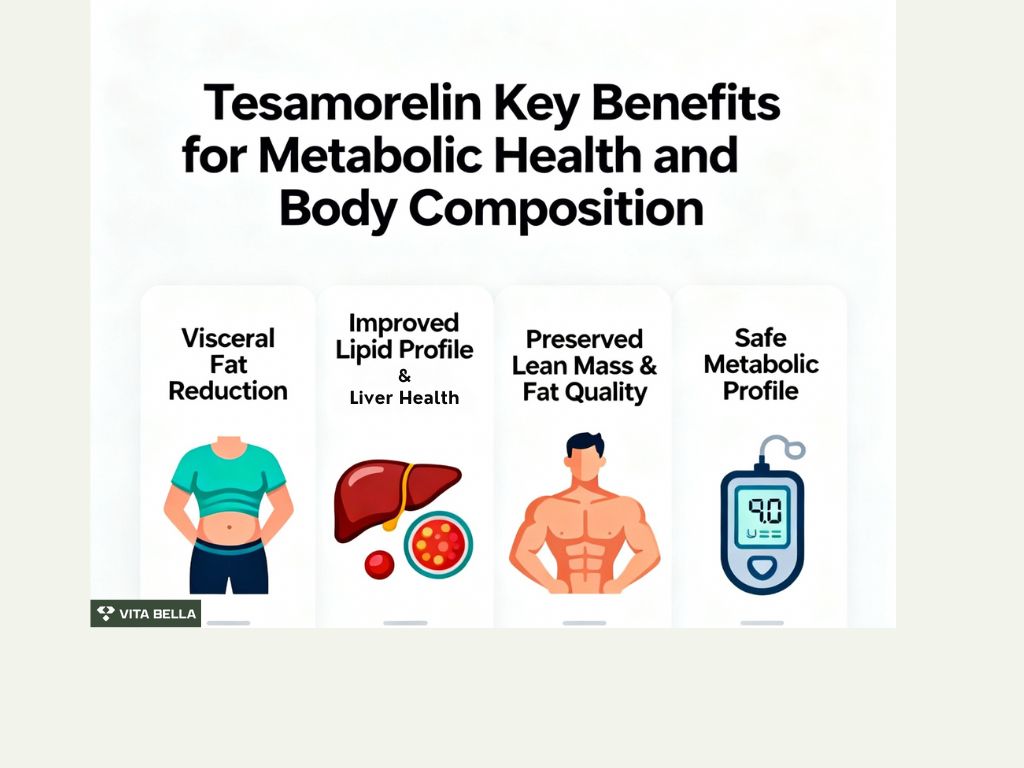Peptide therapies are taking the spotlight in modern health science, showing remarkable potential to tackle stubborn visceral fat, boost metabolic health, and may improve health span. Tesamorelin stands out because it’s FDA-approved 1 specifically for reducing excess abdominal fat in HIV patients with lipodystrophy. What makes it unique is its dual impact: in addition to reducing fat quantity 2, it also improves fat quality (higher fat density). It enhances liver and metabolic outcomes without significant safety concerns.
Looking for targeted fat loss and improved wellness? Discover Tesamorelin and peptide stacking strategies that deliver real results. Take the first step toward a healthier you with Vita Bella!
What is Tesamorelin?
Tesamorelin is a synthetic 44-amino-acid polypeptide analogue of Growth Hormone-Releasing Hormone (GHRH) 1 with modifications to improve stability and pharmacokinetics compared to native GHRH. It activates GHRH receptors in the pituitary, prompting increased release of growth hormone (GH) and downstream production of IGF-1, which contributes to lipolysis, metabolic improvements, and fat redistribution.
The FDA has approved Tesamorelin specifically for the reduction of excess abdominal (visceral) fat in adults living with HIV who have lipodystrophy associated with antiretroviral therapy. Unlike many peptides or hormones used off-label, its approval is backed by trials showing meaningful decreases in visceral adipose tissue 3.
Mechanism of Action of Tesamorelin
Tesamorelin is a synthetic analogue of Growth Hormone–Releasing Hormone (GHRH) that binds to GHRH receptors in the anterior pituitary, triggering the natural (pulsatile) secretion of growth hormone (GH) 1. Once GH rises, it stimulates the liver and peripheral tissues to increase production of insulin-like growth factor-1 (IGF-1), which in turn enhances lipolysis (fat breakdown) and improves metabolic functions.
Studies 1 in people living with HIV shows Tesamorelin reduces visceral adipose tissue (VAT) 2 significantly (≈ 15-18%) over 26-52 weeks, but has minimal impact on subcutaneous fat. Also, rather than just shrinking fat cells, Tesamorelin improves fat quality: increased fat density (smaller, healthier adipocytes) has been observed in visceral and subcutaneous fat with treatment.
Key Benefits of Tesamorelin
Tesamorelin, a synthetic growth hormone-releasing hormone (GHRH) analogue, offers several key benefits related to metabolic health and body composition.
1- Visceral Fat Reduction (~15–18%)
Clinical studies have demonstrated that tesamorelin significantly reduces visceral adipose tissue (VAT) in individuals with HIV-associated lipodystrophy 2. One study reported a reduction of approximately 15–18% in VAT after 6 months of treatment.
2- Improved Lipid Profile & Liver Health
Tesamorelin administration has been associated with improved lipid profile 4, including reductions in triglycerides and total cholesterol levels. Additionally, it has shown potential in reducing liver fat content, which may benefit individuals with non-alcoholic fatty liver disease (NAFLD).
3- Preserved Lean Mass & Improved Fat Quality
Treatment with tesamorelin has been shown to increase lean body mass and decrease waist circumference. Furthermore, it has been associated with improved fat quality 2, characterized by increased fat density, which may have implications for metabolic health.
4- Safe Metabolic Profile (Minimal Glucose Impact)
Studies 5 indicate that tesamorelin does not significantly alter insulin sensitivity or glucose metabolism, even in individuals with type 2 diabetes. This suggests a favorable safety profile concerning glucose homeostasis.
Dosage & Administration: What Beginners Need to Know
Standard Dose: The FDA-approved 1 dosage for tesamorelin is 2 mg administered via subcutaneous injection once daily.
Injection Technique: Inject into the abdomen, avoiding the navel, scar tissue, or bruised areas. Rotate injection sites to minimize irritation and tissue damage. Best practices include rotating injection sites and following proper sterile technique to prevent local irritation or infection.
Monitoring Parameters: Regularly assess insulin-like growth factor 1 (IGF-1) 6 levels, fasting glucose, lipid profile, and waist circumference to evaluate treatment efficacy and safety.

Peptide Stacking with Tesamorelin
Peptide stacking with Tesamorelin is commonly used to enhance fat loss, improve recovery, and support anti-ageing effects. These combinations can provide synergistic benefits for body composition, metabolic health, and recovery from exercise or stress-induced catabolism. Some of the common stacks used include:
1- Tesamorelin + Ipamorelin:
Tesamorelin activates GHRH receptors, while Ipamorelin targets ghrelin receptors, leading to increased GH secretion and improved fat metabolism 7. This combination may enhance visceral fat reduction and support muscle recovery.
Optimizes growth hormone secretion, reduces visceral fat, and aids in tissue repair and recovery.
Scientific evidence 8 supports that this combination effectively increases GH levels and improves body composition without significant adverse effects.
2- Tesamorelin + CJC-1295
Combining Tesamorelin with CJC-1295 offers a synergistic approach to growth hormone (GH) release, enhancing fat loss, muscle recovery, and anti-aging effects. Tesamorelin, a synthetic growth hormone-releasing hormone (GHRH) analog, specifically targets visceral adiposity by stimulating GH release from the pituitary gland. CJC-1295, another GHRH analog, prolongs GH secretion by extending the half-life of endogenous GH-releasing hormone 9.
When used together, Tesamorelin and CJC-1295 can provide a sustained and enhanced GH release, promoting increased IGF-1 levels and improved metabolic outcomes. This combination has shown potential in reducing visceral fat, improving body composition, and supporting overall metabolic health 10.
3- Tesamorelin + Sermorelin
Combining Tesamorelin and Sermorelin offers a synergistic approach to long-term wellness and targeted fat reduction. Tesamorelin 1, a synthetic growth hormone-releasing hormone (GHRH) analog, specifically reduces visceral adiposity by stimulating growth hormone (GH) release from the pituitary gland, leading to decreased abdominal fat in individuals with HIV-associated lipodystrophy.
Sermorelin, also a GHRH analog, stimulates endogenous GH secretion, promoting overall energy and metabolic health. Together, these peptides provide a balanced approach: Tesamorelin targets visceral fat, while Sermorelin supports natural GH production, enhancing energy levels, skin elasticity, and muscle recovery 8.
Take Control of Stubborn Fat and Low Energy with Vita Bella’s Tesamorelin Therapy
Struggling with diets that don’t work, endless workouts that leave you drained, or stubborn belly fat that just won’t go away? Many people face the frustration of doing everything “right” yet still battling fatigue, slow metabolism, and health risks tied to visceral fat. Ignoring these issues can make it harder to regain energy, confidence, and long-term wellness.
That’s where Vita Bella makes the difference. Our Tesamorelin-based therapies directly target harmful abdominal fat, support metabolic balance, and restore vitality, all through a personalized, medically guided approach. With expert oversight, advanced protocols, and a focus on your unique health profile, Vita Bella delivers more than just fat loss: we help you reclaim energy, confidence, and a smarter path to sustainable health.
FAQs
1. What is Tesamorelin and who is it for?
Tesamorelin is a GHRH analogue that reduces visceral fat, improves fat quality, and supports metabolic health, approved for adults with HIV-associated lipodystrophy.
2. How is Tesamorelin administered?
2 mg daily via subcutaneous injection in the abdomen, with rotation of sites and regular monitoring of IGF-1, glucose, and lipid profile.
3. Can Tesamorelin be combined with other peptides?
Yes. Common stacks include Tesamorelin + Ipamorelin, Tesamorelin + CJC-1295, and Tesamorelin + Sermorelin for enhanced fat loss, GH secretion, and recovery.
References:
U.S. National Library of Medicine. (2018, October 20). Tesamorelin. In LiverTox: Clinical and Research Information on Drug-Induced Liver Injury. National Institute of Diabetes and Digestive and Kidney Diseases. https://www.ncbi.nlm.nih.gov/books/NBK548730/
Lake, J. E., La, K., Erlandson, K. M., Adrian, S., Yenokyan, G., Scherzinger, A., Dubé, M. P., Stanley, T., Grinspoon, S., Falutz, J., Mamputu, J.-C., Marsolais, C., McComsey, G. A., & Brown, T. T. (2021). Tesamorelin improves fat quality independent of changes in fat quantity. AIDS, 35(9), 1395–1402. https://doi.org/10.1097/QAD.0000000000002897
ScienceDirect. (n.d.). Tesamorelin. In Encyclopedia of Endocrine Diseases (2nd ed.). Elsevier. Retrieved September 22, 2025, from https://www.sciencedirect.com/topics/medicine-and-dentistry/tesamorelin
Stanley, T. L., Feldpausch, M. N., Oh, J., Branch, K. L., Lee, H., Torriani, M., & Grinspoon, S. K. (2014). Effect of tesamorelin on visceral fat and liver fat in HIV-infected patients with abdominal fat accumulation: A randomized clinical trial. JAMA, 312(4), 380–389. https://doi.org/10.1001/jama.2014.8334





















